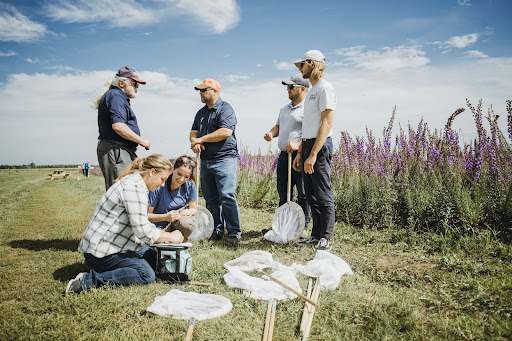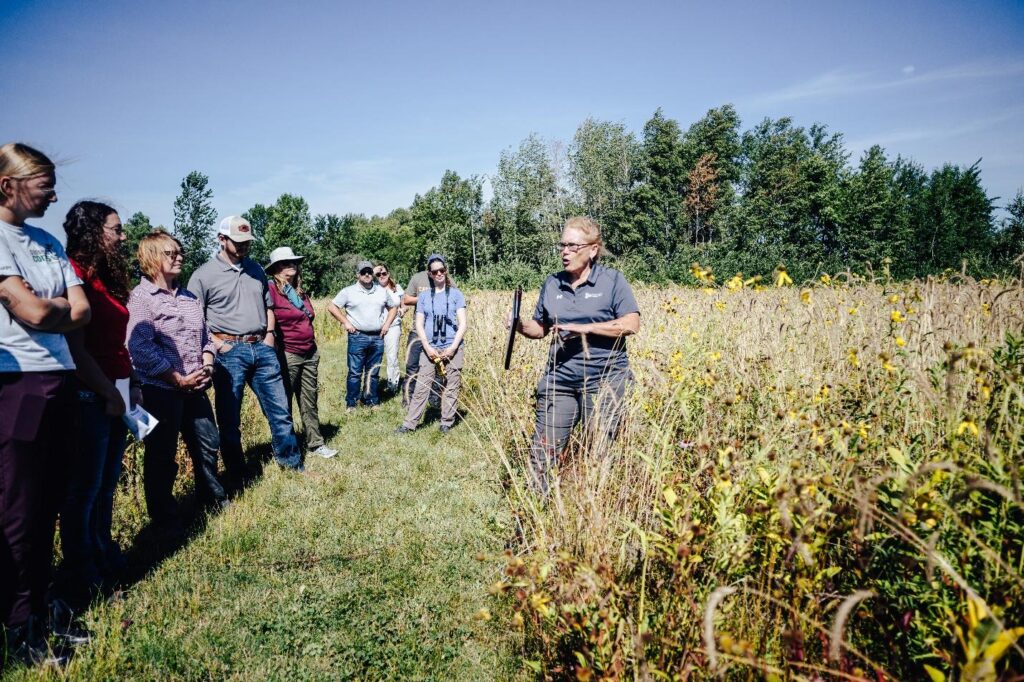Where are the monarchs now?
The monarch migration is now moving through Iowa and has entered northern Kansas. By the week of September 25th they should reach central Oklahoma. The first monarchs usually reach the border with Mexico in the first week of October. Follow their migration at Journey North.

The U.S. Fish and Wildlife Service’s Center for Pollinator Conservation hosted the annual in-person meeting of the Farmers for Monarchs collaborative last month in Bloomington, Minnesota, bringing together farmer groups, conservationists, federal agencies, and agricultural supply chain companies to discuss critical issues surrounding the monarch butterfly. This gathering marked a significant milestone as it was the first in-person partnership meeting hosted by the Center for Pollinator Conservation.
The group discussed the Farmers for Monarchs 2024 action plan and strategy for both the communications and policy working groups. Several pressing topics were addressed and highlighted during the two-day meeting, underscoring the collaborative's commitment to monarch butterfly conservation. Here's a brief overview of the key highlights from the event:
Endangered Species Act Listing Decision Timeline: An important discussion from the meeting revolved around the timeline of the decision regarding the potential listing of the monarch butterfly under the Endangered Species Act (ESA). Nicole Alt, the director of the Center for Pollinator Conservation, reported that the decision will be made by September 2024. This decision has far-reaching implications for both farmers and conservationists, making it a top priority for Farmers for Monarchs members to remain informed about.
Environmental Protection Agency Becoming Compliant with Endangered Species Act: The group was joined by Jake Li, Deputy Assistant Administrator for Environmental Protection Agency’s (EPA) Office of Pesticide Programs who discussed how the agency is working to become compliant with the Endangered Species Act. The agency is moving away from a chemical-by-chemical and species-by-species approach to a more standardized and programmatic approach. For many decades, EPA has been making Federal Insecticide, Fungicide, and Rodenticide Act decisions that are not fully compliant with the ESA, and the courts have made it clear that this is unacceptable. The agency is fully embracing their ESA obligations and, in April 2022, released a comprehensive work plan for reaching compliance, a process that realistically will take 8-10 years. Jake and the group discussed the herbicide strategy as well as how utilizing avoidance, minimization and off-sets (compensatory mitigation) are all on the table for addressing these issues.
Farmer awareness about monarchs and the ESA: In the weeks leading up to the plenary meeting, Farmers for Monarchs asked members to engage farmers within their network to take a brief survey to gauge their feelings about the potential impact a listing decision on the monarch could bring. And while the listing decision is next year, it was a valuable discussion to fully understand farmer perspectives. Some of the concerns and unknowns farmers had with regard to the possibility of a monarch listing include restrictions or new regulations on:
- Pesticide use for crop production.
- Placement of new buildings.
- Converting non-crop land that may contain pollinator habitat.
- Milkweed within crop areas
This information is incredibly helpful to Farmers for Monarchs as we aim to provide farmers with the most up-to-date and accurate information navigating their conservation activities in the face of a possible monarch butterfly listing.

Field Activities: Farmers for Monarchs attendees also engaged in field activities to demonstrate hands-on conservation efforts of the group. The group visited Bee and Butterfly Habitat Fund pollinator habitat installations, tagged monarch butterflies, and visited Minnesota Native Landscapes, a company that grows native plants and harvests and sells native seed. Click here to see the diversity included in the Minnesota butterfly seed mix, which includes more than 50 different species of plants in the blend!
Recognition of Chip Taylor: One of the standout moments of the meeting was the recognition of Chip Taylor, a valued member of the coalition. Taylor was presented with a well-deserved letter of recognition from Lori Nordstrom, Assistant Regional Director, Ecological Services at the USFWS, for his exceptional contributions to monarch butterfly conservation.

The annual in-person plenary meeting of the Farmers for Monarchs collaborative served as a testament to the power of collaboration between farmers, conservationists, agribusiness, and government agencies. As discussions continue and efforts are redoubled, the group strives to develop innovative solutions that safeguard the monarch butterfly's future and work with the agricultural community.
